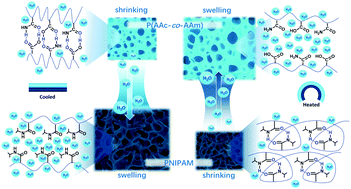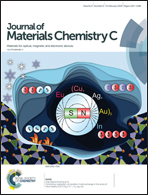Mimosa inspired bilayer hydrogel actuator functioning in multi-environments†
Abstract
Hydrogel-based actuators have attracted significant attention and shown promising applications in many fields. However, most hydrogel actuators can only act in aqueous media, which dramatically limits their applications. Hence, the realization of hydrogel actuators that function under non-aqueous conditions still remains a significant challenge. Inspired by the water self-circulation mechanism that contributes to the motion of Mimosa leaves, we herein present a general strategy towards designing hydrogel actuators that can generate motions in water, oil and even in open-air environments. A hydrogel with a reverse thermal responsive bilayer composite structure was prepared, composed of a hydrogel layer derived from a polymer featuring a lower critical solution temperature (LCST layer) and a hydrogel layer derived from a polymer featuring an upper critical solution temperature (UCST layer). Upon heating, water molecules were transferred from the LCST layer to the UCST layer within the bilayer hydrogel, while under cooling the reverse process took place, allowing for an actuation even in non-aqueous environments. This water self-circulation within the bilayer hydrogel enabled a bending of the hydrogel and hence offers a smart strategy yet with a new idea for actuators working in multi-environments. Such hydrogel actuators may provide new insights for the design and fabrication of intelligent soft materials for bio-inspired applications.

- This article is part of the themed collection: 2018 Journal of Materials Chemistry C HOT Papers


 Please wait while we load your content...
Please wait while we load your content...